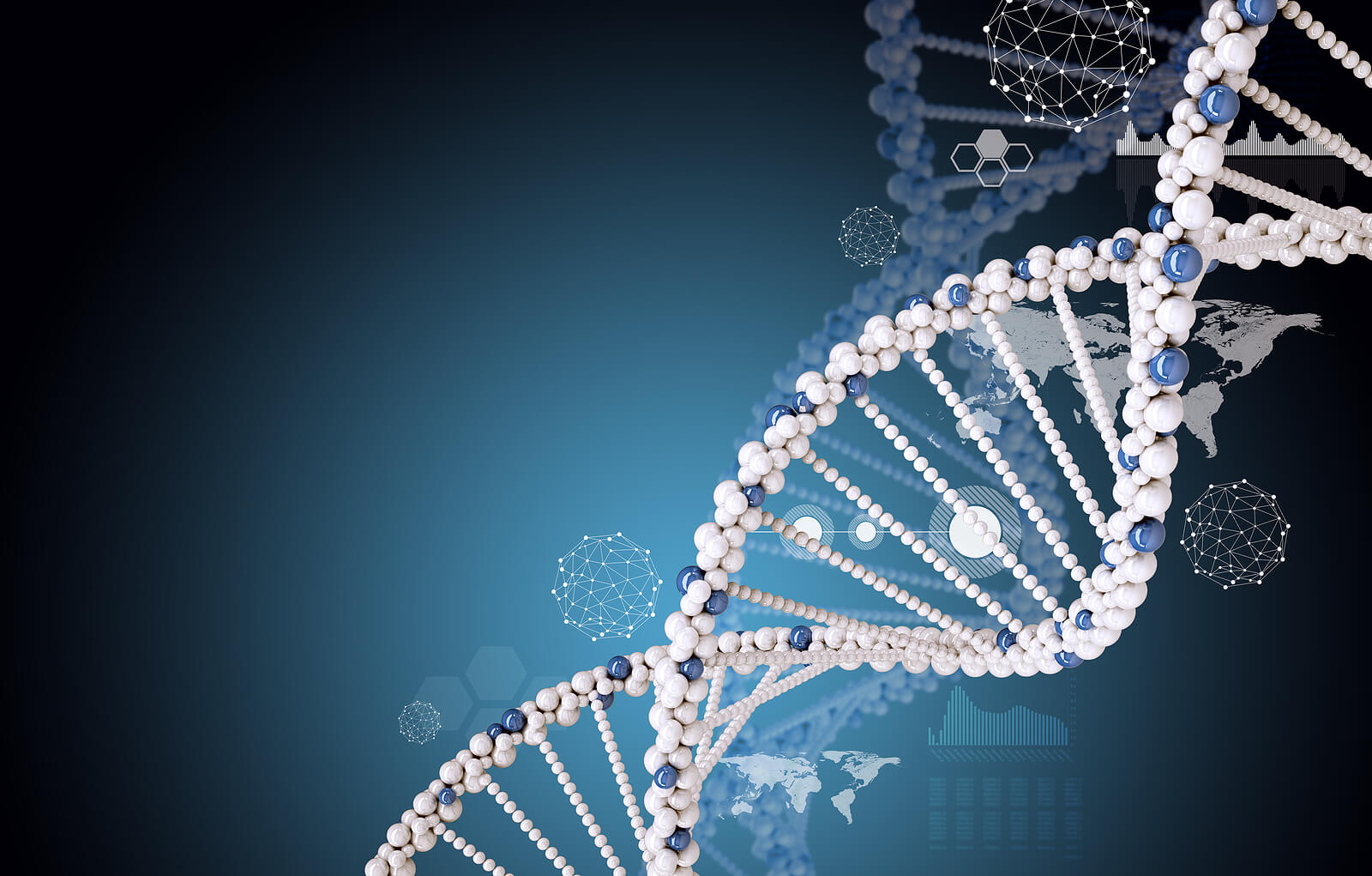Types of Collagen?

Collagen is a protein molecule whose function is to serve as a link in connective tissue. It’s the most abundant protein in the body, occupying almost 25% of its total mass. Among other things, the role of collagen is to help tendons and skin to be flexible, strengthen bones, tendons, cartilage, and speed recovery after injury. Find out about the types of collagen right here.
The body produces the collagen it needs on its own. Most are generated in fibroblasts, a type of cell that resides in connective tissue. You can also acquire it through food or with the help of supplements. Collagen deficiency is related to several complications, as we’ll see later.
Types of collagen

The base molecule of collagen is part of a large family of substances that, even though they share characteristics in common, fulfill different functions.
At a genetic level, these molecules also differ, and around 28 types have been identified. According to the researchers, the most important are the following.
Type I
Studies agree that this is the most abundant variant in the entire body. It’s present in almost all connective structures, with the greatest emphasis on skin, bones, tendons, teeth, and cartilage. It’s believed that it occupies 90% of the volume of this protein in the whole body.
Type II
It’s found in almost all cartilage in the body. Therefore, its function is to shape and provide structure to the nose, ears, and joints. People who suffer from arthritis, in any of its types, generally have a greater deficiency of this variant.
Type III
Evidence indicates that type III collagen makes up between 5% and 20% of the total protein in the human body. It provides structural integrity to arteries, uterus, intestines, muscles, and blood vessels. Have you discovered the pattern? That’s right, this variant is found in the expandable areas of the body.
Type IV
Although we can also find it in other areas, researchers agree that this type has a leading role in the layers of the skin. It fulfills support and filtration functions, and is only produced in the basement membranes.
The other variants of the protein are found in higher proportions, although their role continues to be important for bone, joint, muscle, cartilage, and skin health.
Joint pain, reduced bone density, and lack of flexibility or wrinkles in the skin develop in the event of its deficiency.
What is collagen deficiency?
Collagen production decreases with age. This manifests itself visibly on the surface of the skin, but also internally.
Cartilage, muscles, tendons, and joints all deteriorate in structure. The process is natural, and, while some habits can help slow it down, it can’t be prevented.
The creation of protein can also be interrupted by various diseases. Although there are dozens, we highlight the following among the main ones:
- Scurvy: Known centuries ago as sailors’ disease, scurvy is simply a vitamin C deficiency. Studies indicate that this vitamin plays a key role in collagen metabolism, so its deficiency creates a snowball effect with respect to protein.
- Ehlers-Danlos syndrome: It isn’t a single condition, but a group of conditions that are characterized by damage to the connective tissue. This genetic disease is distinguished by enormous flexibility in the joints and skin.
- Osteogenesis imperfect: Also informally known as crystal bone disease, its origin is genetic and prevents the body from developing strong bone matter. Although it interrupts other functions, it’s distinguished by preventing the formation of collagen in the bones.
- Cutis laxa: This condition is characterized by wrinkled, lax, or sagging skin. Despite this, the folds aren’t flexible. It’s usually diagnosed during the first few years of life.
Autoimmune disorders such as lupus, rheumatoid arthritis, scleroderma, or ankylosing spondylitis attack connective tissue, creating deficiencies in specific areas. In fact, in the beginning, all of these were known as collagen vascular diseases.
You can also have collagen deficiency if you don’t maintain a balanced diet after a certain age. The amount that the body produces begins to decrease shortly before the age of 30, and gradually decreases in the following decades. If you don’t include the amino acids and nutrients necessary for its creation, the process accelerates even more.
As Harvard TH Chan reminds us, smoking, alcohol, prolonged sun exposure, lack of sleep, and excessive exercise are also associated with collagen deficiency.
How can I get more collagen?

Although a decrease in production can’t be completely prevented, you can tip the balance in your favor through a series of habits.
The first thing is to reverse the habits that we mentioned a moment ago. That is, reduce or eliminate tobacco and alcohol intake, sleep at least 8 hours a day, and use sunscreen, hats, and long-sleeved shirts if you constantly spend time in open spaces in the sun.
Similarly, athletes must follow a special diet to combine their activities with a good proportion of protein in the body. You can also consider taking collagen supplements. These are available in various presentations, although one of the most practical is hydrolyzed collagen powder.
Supplement intake is actually secondary to a balanced diet. Products of animal origin, such as meat, chicken, or fish, supply you with enough collagen.
Beans, legumes, and gelatin also provide you with a significant amount. A diet rich in amino acids such as proline, glycine, and hydroxyproline aids in the protein-building process.
In general, you must maintain a healthy life to ensure that your collagen stores are in line with your age. Don’t worry about the levels going down as you age. It’s a natural process that also manifests itself with other organic functions.
Collagen is a protein molecule whose function is to serve as a link in connective tissue. It’s the most abundant protein in the body, occupying almost 25% of its total mass. Among other things, the role of collagen is to help tendons and skin to be flexible, strengthen bones, tendons, cartilage, and speed recovery after injury. Find out about the types of collagen right here.
The body produces the collagen it needs on its own. Most are generated in fibroblasts, a type of cell that resides in connective tissue. You can also acquire it through food or with the help of supplements. Collagen deficiency is related to several complications, as we’ll see later.
Types of collagen

The base molecule of collagen is part of a large family of substances that, even though they share characteristics in common, fulfill different functions.
At a genetic level, these molecules also differ, and around 28 types have been identified. According to the researchers, the most important are the following.
Type I
Studies agree that this is the most abundant variant in the entire body. It’s present in almost all connective structures, with the greatest emphasis on skin, bones, tendons, teeth, and cartilage. It’s believed that it occupies 90% of the volume of this protein in the whole body.
Type II
It’s found in almost all cartilage in the body. Therefore, its function is to shape and provide structure to the nose, ears, and joints. People who suffer from arthritis, in any of its types, generally have a greater deficiency of this variant.
Type III
Evidence indicates that type III collagen makes up between 5% and 20% of the total protein in the human body. It provides structural integrity to arteries, uterus, intestines, muscles, and blood vessels. Have you discovered the pattern? That’s right, this variant is found in the expandable areas of the body.
Type IV
Although we can also find it in other areas, researchers agree that this type has a leading role in the layers of the skin. It fulfills support and filtration functions, and is only produced in the basement membranes.
The other variants of the protein are found in higher proportions, although their role continues to be important for bone, joint, muscle, cartilage, and skin health.
Joint pain, reduced bone density, and lack of flexibility or wrinkles in the skin develop in the event of its deficiency.
What is collagen deficiency?
Collagen production decreases with age. This manifests itself visibly on the surface of the skin, but also internally.
Cartilage, muscles, tendons, and joints all deteriorate in structure. The process is natural, and, while some habits can help slow it down, it can’t be prevented.
The creation of protein can also be interrupted by various diseases. Although there are dozens, we highlight the following among the main ones:
- Scurvy: Known centuries ago as sailors’ disease, scurvy is simply a vitamin C deficiency. Studies indicate that this vitamin plays a key role in collagen metabolism, so its deficiency creates a snowball effect with respect to protein.
- Ehlers-Danlos syndrome: It isn’t a single condition, but a group of conditions that are characterized by damage to the connective tissue. This genetic disease is distinguished by enormous flexibility in the joints and skin.
- Osteogenesis imperfect: Also informally known as crystal bone disease, its origin is genetic and prevents the body from developing strong bone matter. Although it interrupts other functions, it’s distinguished by preventing the formation of collagen in the bones.
- Cutis laxa: This condition is characterized by wrinkled, lax, or sagging skin. Despite this, the folds aren’t flexible. It’s usually diagnosed during the first few years of life.
Autoimmune disorders such as lupus, rheumatoid arthritis, scleroderma, or ankylosing spondylitis attack connective tissue, creating deficiencies in specific areas. In fact, in the beginning, all of these were known as collagen vascular diseases.
You can also have collagen deficiency if you don’t maintain a balanced diet after a certain age. The amount that the body produces begins to decrease shortly before the age of 30, and gradually decreases in the following decades. If you don’t include the amino acids and nutrients necessary for its creation, the process accelerates even more.
As Harvard TH Chan reminds us, smoking, alcohol, prolonged sun exposure, lack of sleep, and excessive exercise are also associated with collagen deficiency.
How can I get more collagen?

Although a decrease in production can’t be completely prevented, you can tip the balance in your favor through a series of habits.
The first thing is to reverse the habits that we mentioned a moment ago. That is, reduce or eliminate tobacco and alcohol intake, sleep at least 8 hours a day, and use sunscreen, hats, and long-sleeved shirts if you constantly spend time in open spaces in the sun.
Similarly, athletes must follow a special diet to combine their activities with a good proportion of protein in the body. You can also consider taking collagen supplements. These are available in various presentations, although one of the most practical is hydrolyzed collagen powder.
Supplement intake is actually secondary to a balanced diet. Products of animal origin, such as meat, chicken, or fish, supply you with enough collagen.
Beans, legumes, and gelatin also provide you with a significant amount. A diet rich in amino acids such as proline, glycine, and hydroxyproline aids in the protein-building process.
In general, you must maintain a healthy life to ensure that your collagen stores are in line with your age. Don’t worry about the levels going down as you age. It’s a natural process that also manifests itself with other organic functions.
- Abreu-Velez, A. M., & Howard, M. S. (2012). Collagen IV in normal skin and in pathological processes. North American journal of medical sciences. 2012; 4(1): 1.
- Henriksen, K., & Karsdal, M. A. Type I collagen. In Biochemistry of collagens, laminins and elastin. 2016; 1-11.
- Kuivaniemi, H., & Tromp, G. Type III collagen (COL3A1): gene and protein structure, tissue distribution, and associated diseases. Gene. 2019; 707: 151-171.
- Ricard-Blum, S. (2011). The collagen family. Cold Spring Harbor perspectives in biology. 2011; 3(1).
- Tuero, B. B. Funciones de la vitamina C en el metabolismo del colágeno. Rev Cubana Aliment Nutr. 2000; 14(1): 46-54.
Este texto se ofrece únicamente con propósitos informativos y no reemplaza la consulta con un profesional. Ante dudas, consulta a tu especialista.







